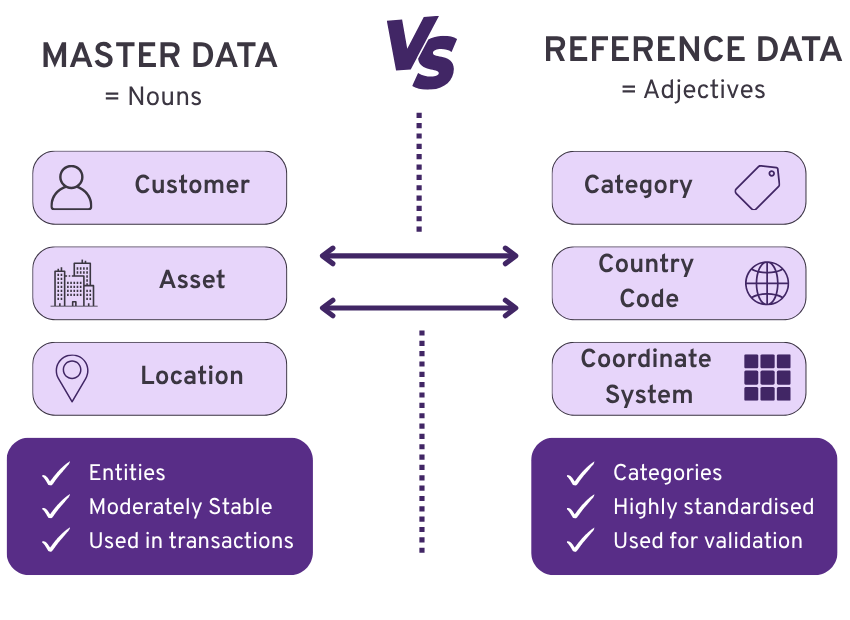Master Data vs. Reference Data
The Data Debate You Didn’t
Know You Were Having
Have you ever been in a meeting where everyone thinks they’re talking about the same thing, but they’re not? It’s a common challenge in technical fields, especially when it comes to data. Misunderstanding key terms can lead to confusion, misaligned strategies, and even flawed decision-making.
So why does this matter? In today’s data-driven world, especially in sectors like utilities, transport, and government, the ability to distinguish between Master Data and Reference Data is more than just semantics, it’s foundational to building trusted, interoperable systems. Misunderstanding these concepts can lead to poor data quality, inefficient processes, and costly integration issues. At 1Spatial, where we help organisations unlock the value of location data, clarity between these two data types is essential for delivering smarter, more reliable solutions. Whether you're designing geospatial systems, managing infrastructure assets, or aligning teams around shared definitions, understanding this distinction is a strategic advantage.
In the world of data management, few terms are as frequently misunderstood, or used interchangeably, as Master Data and Reference Data. While both are foundational to enterprise data architecture, particularly in areas like geospatial intelligence and Master Data Management (MDM), they serve distinct roles and require tailored governance approaches. This article aims to demystify these two concepts, clarify their differences, and explore how they interact, especially within the context of geospatial business applications.
What is Master Data?
Master Data refers to the core entities that are essential to business operations. Think of it as the “nouns” of your business: customers, products, assets, locations. These are the foundational elements that appear across multiple systems and processes.
According to DAMA International, Master Data consists of critical data entities used repeatedly across systems. Managing this data effectively, through Master Data Management (MDM), ensures consistency, accuracy, and a single version of truth.
Key characteristics of Master Data:
- Represents core business entities
- Shared across systems and departments
- Moderately stable over time
- Supports transactions, analytics, and reporting
- Requires governance and stewardship
Example:
A utility company’s asset register might include every transformer, substation, and pipeline. Each asset has a unique ID, location, installation date, and maintenance history… this is Master Data.


What is Reference Data?
Reference Data provides the standardised values used to describe or categorise Master Data. It’s the “adjectives” of your data world used to ensure consistency and clarity across systems
DAMA defines Reference Data as data used to classify or relate other data, often based on external standards.
Key characteristics of Reference Data:
- Highly standardised, often externally defined (e.g., ISO codes)
- Relatively static and widely reused
- Used for validation and categorisation
- Typically stored in reference tables
Example:
Country codes, currency codes, or coordinate reference systems. When you select a country from a dropdown menu, you’re interacting with Reference Data.
Master vs. Reference Data at a glance
Why the confusion?
It's easy to understand why master data and reference data are often confused, both are shared across systems, remain relatively stable over time, and play a critical role in ensuring data quality.
But the key difference lies in their function:
- Master Data represents entities (e.g., a customer or asset)
- Reference Data represents categories or values used to describe those entities (e.g., asset type or country code)


Real-world examples
Land Parcel Management
Master Data: Parcel ID, geometry, owner, address
Reference Data: Land use codes, zoning classifications, coordinate systems
Utility Asset Management
Master Data: Asset ID, location, installation date
Reference Data: Asset types, condition ratings, maintenance status codes
In both cases, Reference Data provides the semantic structure that gives meaning to Master Data and ensures consistency across systems.
Governance Considerations
Master Data
- Needs data stewards to manage lifecycles
- Requires quality rules (e.g., uniqueness, completeness)
- Often involves workflows and approvals
Reference Data
- Requires version control and change management
- May involve external standards bodies (e.g., ISO, OGC)
- Needs synchronisation across systems to avoid mismatches
Managing Master and Reference Data requires these tailored governance strategies.
Best Practices for Managing Both
For Master Data:
- Invest in a centralised MDM platform
- Define clear data ownership
- Implement robust data quality strategies
For Reference Data:
- Maintain a central repository
- Use recognised code sets (e.g., ISO, EPSG)
- Document definitions, version changes, and usage rules
Together, these practices help build a coherent, high-quality data ecosystem.
Why It Matters
Master Data and Reference Data may seem like subtle distinctions, but they play fundamentally different roles in how organisations manage, interpret, and trust their data.
Understanding the difference isn’t just a technical detail… it’s a strategic advantage. When clearly defined and properly governed, these two types of data unlock better data quality, smoother integrations, and more reliable insights.
Whether you're building geospatial systems, managing customer records, or aligning teams around shared definitions, clarity in these foundational elements sets the stage for smarter decisions and stronger collaboration.
Article written by David Cavero Montaner, Principal Consultant I, 1Spatial
Ready to Take Control of Your Data?
Contact us today to start a conversation about your data challenges and discover how we can help you build a smarter, more trusted data ecosystem.
Contact
